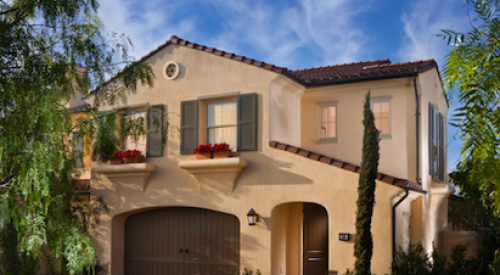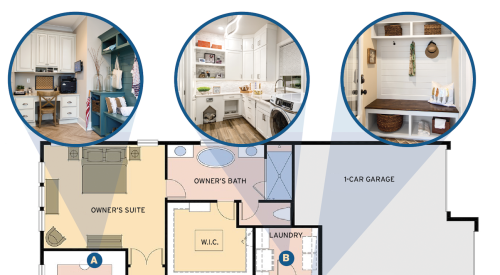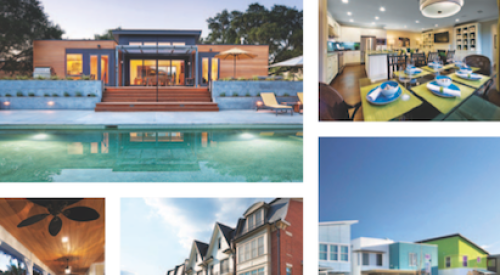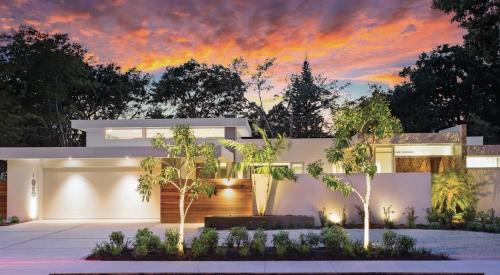|
Sutter's Mill, at Ladera Ranch in Orange County, Calif., is a rear-loaded village of two- and three-story townhouses, built at 19 units per acre. It wows entry-level buyers with a kaleidoscope of bold colors and changing materials in a contemporary, stylized interpretation of old mining camp architecture. Builder Centex Homes opened models in March, sold 126 of 152 units by October.
|
|
|
|
|
Rooms Interiors uses color to differentiate models. Shown here: 1,473 square-foot Plan 1 called "mixed metals."
|
|
|
Plan 1 master bedroom shows softer side of treatments interior merchandiser Dee Dee O'Leary calls "edgy, but not over the top."
|
Earlier this fall, best-selling author Seth Godin urged his builder audience at PB's annual Benchmark conference to sell "purple cows"ù housing products that immediately differentiate themselves from all others in the marketplace. He must have had Centex Homes' Sutter's Mill in mind.
Tightly targeted to buyers fitting a specific psychographic as well as demographic profile, Sutter's Mill is an entry-level condo townhouse community at Ladera Ranch in Orange County, Calif., that may herald the long-anticipated return of contemporary architecture to the production-built housing marketplace. Dave Kosco, senior principal of Bassenian/Lagoni Architects, headed the team that designed Sutter's Mill. He describes it as "stylized California agrarian meets old mining town." But we prefer to call it surreal modernism. While there are certainly hints of mining shacks and beach houses here, what hits you from a mile away is the use of color ù including purple ù as a point of differentiation.
Opportunities
Like every other land parcel at Rancho Mission Viejo's master-planned community of Ladera Ranch, this one of eight acres, in Ladera's new Terramor village, was put into a request for proposal design competition in 2002 involving a number of Southern California builders and architects. When Ladera conducts these competitions, it provides the design/build teams with very specific targets for density, buyer profile and price point based on Ladera's intensive market and consumer research.
In this case, Ladera decided the target should be young, entry-level buyers fitting the "cultural creative" psychographic profile. Ladera's research indicated that 32% of young adults in southern Orange County fit this profile characterized by altruism, idealism and strong environmentalism. What makes this market segment especially attractive is that research showed these buyers have few new-home options in the area to match their preferences. Rather, cultural creatives migrate to the resale market, looking for neighborhoods with an authentic feeling of home and community. Even though they are among the best-educated buyers and usually have higher than average incomes, cultural creatives look for diverse living experiences. They are often turned off by the newness of master-planned communities and sameness of the people in them.
"What Ladera told us," says Nick Lehnert, Centex South Coast's director of product development, "is that the cultural creatives would rather rent than live in a master-planned community, but that Terramor would attract them with an entire village tailored to their lifestyles and values.
"These are people who would rather read books and paint than watch TV," he continues. "They are politically liberal and sensitive about the environment. Right upfront, we were required to design a product that is ægreen,' with elements such as passive cooling, solar heating, and electric vehicle recharging stations in every garage.
"Ladera wanted an architectural style they described as æabstract national,'" Lehnert adds. "The Sutter's Mill parcel is relatively close to the entry of this new village of Terramor, so we saw an opportunity to create sort of a billboard for the village."
"We knew the architecture here was really important to Ladera," says Kosco, "so we decided to make a bold statement that this is not just another suburban housing project. We had to be different."
Obstacles
Centex and Bassenian/Lagoni settled quickly on a modular-condo building type that allows them to meet their high density target, and get pricing down to entry level. "But we were struggling with what we could do to make a long, condo townhouse building different," says Lehnert. "How could we break it up?"
Dave Kosco and his team traveled extensively to find inspiration for the "abstract national" style Ladera wanted. "That's an ambiguous term," Kosco says, "but we used it to open the door to something a little more abstract and contemporary ù a real contrast to the colonial, French and Italian styles that dominate the rest of Ladera. We went up to the Sonoma and Napa valleys and photographed a lot of wineries and other rural buildings. Gradually, we began to develop the aesthetic you see in Sutter's Mill."
The concept wowed Ladera and won the design competition for the site. "I was really excited when I first saw it," Lehnert says. "It doesn't even look residential. It's a contemporary, stylized interpretation of an old mining town. That's why we named it Sutter's Mill, after the Gold Rush site. It's only slightly toned down from the first sketches ."
Outcome
Sutter's Mill features two- and three-story townhouses with attached garages reached via internal alleys. In addition to its stunning colors, the design team uses an array of roofing and siding materials (fiber-cement, stucco and unfinished, corrugated tin) and architectural elements such as porches, balconies, projecting third-story bedrooms and cantilevered third-story master retreats. All these materials and elements break up the facades of long buildings containing five to eight townhouses each.
The community sets a new standard for green building in Southern California, and markets that greenness aggressively:
- Marketing materials inform shoppers that 50% of job-site construction waste is recycled, while a photovoltaic system captures solar energy.
- Faucets have flow reducers (2.2 gallons per minute) and toilets are all low-flush (1.6 gallons per flush).
- Fluorescent lighting fixtures are used extensively, and ceiling fans are optional in every townhouse.
- Every garage has a 110-volt electric car-recharging outlet.
- Windows are all low-e, insulated glass, and an advanced sealing and insulation package exceeds California's energy efficiency requirements by percent. Paints are all water-based. Every kitchen has a recycling station.
- All appliances are Energy Star-rated.
Most importantly for Centex and Ladera, Sutter's Mill is a huge hit with homebuyers. "This is one of the most successful developments in the history of Ladera Ranch," Lehnert says. "Even though we raised prices aggressively from phase to phase, we've averaged 3.9 sales a week for the last eight weeks." In fact, the project is averaging 2.8 sales a week over its whole history, which includes a long pre-sales period from last November to March. By mid-October this year, Sutter's Mill had 126 of the 152 townhouses sold, and Centex plans to reach build-out next June.
The two- and three-story townhouses range from 1,327 to 1,686 square feet. Prices began at $340,990 to $377,990, but now run from $426,290 to $496,890.
"Even with those increases, this is still one of the five most affordable new-home communities in Orange County," Lehnert says "That's why our buyer segment is a little broader than the cultural creatives Ladera targeted. We've attracted young, hip first-time buyers with a product that is different ù really unique, in fact ù but they don't all wear Birkenstocks and drive electric cars."
With all its innovations in materials, Sutter's Mill is expensive to build. (The custom-fabricated, cable-supported awnings and shutters are especially noteworthy.) "We took a major hit after construction started, when Orange County decided to place this under a code that is virtually commercial, because of the three-story height," Lehnert says. "So we had to put smoke dampers in every unit at a cost of $5,000 each. That drove our hard costs [materials and labor] up to $100 a square foot."
However, Centex is now planning to build the Sutter's Mill product at several locations in the Inland Empire. "We think we can get our costs down to the low $90s a square foot there," Lehnert says.












